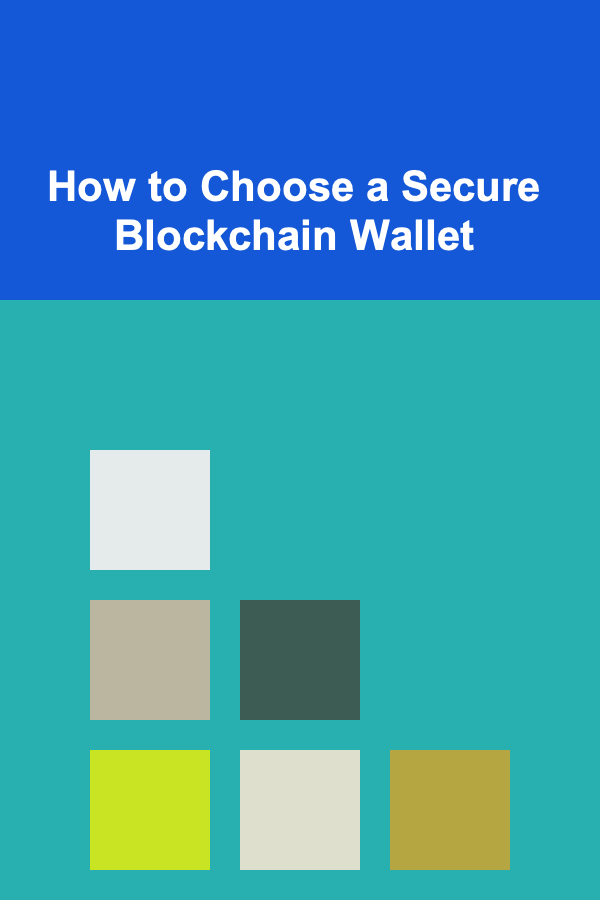
How to Choose a Secure Blockchain Wallet
ebook include PDF & Audio bundle (Micro Guide)
$12.99$5.99
Limited Time Offer! Order within the next:

Blockchain technology has revolutionized various industries, providing innovative ways to secure digital transactions and information. Central to this innovation is the use of blockchain wallets, which allow users to store and manage cryptocurrencies securely. However, with the increasing popularity of cryptocurrencies and blockchain-based applications, choosing a secure blockchain wallet is becoming more critical than ever. In this article, we will explore the essential aspects to consider when selecting a blockchain wallet, the different types of wallets available, and the best practices to keep your assets safe.
The Importance of a Secure Blockchain Wallet
Blockchain wallets are the gateways to your cryptocurrency and digital assets. These wallets store the cryptographic keys needed to authorize transactions on the blockchain, and the security of these keys is paramount. If someone gains access to your wallet, they can potentially access and transfer your digital assets without your permission. A compromised wallet can lead to significant financial losses, especially with the rise in popularity and value of cryptocurrencies like Bitcoin, Ethereum, and other altcoins.
In addition to the financial aspect, blockchain wallets can also hold tokens representing ownership of assets, voting rights in decentralized applications, and other important digital information. Therefore, choosing a secure wallet is not only about protecting your money but also about safeguarding your digital identity and assets in the blockchain ecosystem.
Key Features of a Secure Blockchain Wallet
When selecting a secure blockchain wallet, several features should be considered to ensure the safety and usability of your digital assets:
1. Private Key Control
The private key is the most critical component of a blockchain wallet. It is the cryptographic key that allows you to access and control your funds. The security of your private key determines the security of your wallet, so it is essential to choose a wallet that gives you full control over your private keys.
There are two main types of wallets based on private key control:
- Non-custodial wallets: In these wallets, you retain full control over your private keys. This means that only you can access and manage your funds. Non-custodial wallets are often considered more secure because they eliminate the risk of a third party being hacked or mismanaging your funds.
- Custodial wallets: With custodial wallets, a third party (such as an exchange or wallet provider) controls your private keys. While custodial wallets are more user-friendly, they come with the risk of the third party being compromised or losing your keys.
When selecting a wallet, it is crucial to decide whether you are comfortable with the responsibility of managing your private keys. If you choose a custodial wallet, ensure that the provider is trustworthy and has a strong track record of security.
2. Encryption and Backup Features
A good blockchain wallet should offer robust encryption and backup features to protect your keys from theft and loss. Most wallets encrypt your private keys with advanced cryptographic algorithms, making it difficult for attackers to access your funds.
Additionally, secure wallets should offer a way to back up your keys, often through a seed phrase or recovery phrase. This phrase is a series of words generated when you first set up the wallet, which can be used to restore your wallet if your device is lost or stolen. It is crucial to store your recovery phrase in a secure and offline location, such as a hardware device or a paper copy, and never share it with anyone.
3. Two-Factor Authentication (2FA)
Two-factor authentication (2FA) adds an extra layer of security to your wallet by requiring two forms of identification before granting access to your account. This typically involves something you know (your password) and something you have (a second factor such as a code sent to your phone or generated by an authentication app).
Many blockchain wallet providers offer 2FA as an option, and it is highly recommended to enable it for an added layer of protection. Even if someone gains access to your password, they would still need the second factor to access your wallet.
4. Multi-Signature Support
Multi-signature (multi-sig) wallets require multiple private keys to authorize a transaction. This means that even if one key is compromised, the funds remain secure as long as the other keys are still under your control.
Multi-signature wallets are particularly useful for organizations or individuals who want to ensure that no single person can access the funds without the approval of others. For example, a business might require multiple executives to sign off on transactions before funds can be moved.
5. Security Audits and Reputation
Before choosing a blockchain wallet, it is essential to research its security track record. Reputable wallet providers will undergo regular security audits to identify and fix potential vulnerabilities. Look for wallets that have been independently reviewed and have a history of secure operations.
It is also helpful to check for any past security breaches or hacks related to the wallet provider. If a wallet has experienced multiple security failures or incidents, it may not be the best choice for protecting your assets.
6. Open-Source Software
Open-source software allows anyone to inspect the wallet's code, providing transparency and enabling the community to identify any potential vulnerabilities. Wallets that are open-source tend to be more secure because they undergo public scrutiny, which helps identify flaws and weaknesses that could be exploited by attackers.
Open-source wallets also offer greater trust, as they do not rely on the integrity of a single organization or provider. Users can verify that the wallet does not contain any malicious code by inspecting the codebase.
7. User Experience
While security is paramount, a secure blockchain wallet should also be user-friendly. The wallet should have an intuitive interface that allows you to easily access and manage your assets. Complex or poorly designed wallets can increase the risk of user errors, such as sending funds to the wrong address or losing access to your wallet.
Look for wallets that provide clear instructions, easy navigation, and a straightforward setup process. Some wallets also offer additional features, such as transaction history and portfolio management, which can enhance the user experience.
Types of Blockchain Wallets
There are several types of blockchain wallets, each with its own security features, advantages, and disadvantages. The main types are:
1. Hardware Wallets
Hardware wallets are physical devices that store your private keys offline. They are considered one of the most secure types of wallets because they are immune to online attacks. When using a hardware wallet, your private keys never leave the device, making it nearly impossible for hackers to access them remotely.
Popular hardware wallet providers include Ledger and Trezor, both of which offer devices that support a wide range of cryptocurrencies. Hardware wallets are best suited for long-term storage of digital assets and for individuals who need maximum security.
2. Software Wallets
Software wallets are applications or programs that run on your computer or mobile device. They can be divided into desktop wallets, mobile wallets, and web wallets.
- Desktop wallets are installed on your computer and store your private keys locally. They are generally secure as long as your computer is free of malware, but they are still vulnerable to attacks if your device is compromised.
- Mobile wallets are apps designed for smartphones and tablets. They offer convenience and portability, but they are also more vulnerable to loss or theft if the device is compromised.
- Web wallets are hosted online and can be accessed through a browser. While they are easy to use, they are also more vulnerable to hacking and phishing attacks. It is important to choose a reputable web wallet provider and use 2FA for extra protection.
3. Paper Wallets
A paper wallet is a physical printout of your public and private keys. This type of wallet is considered highly secure because it is completely offline and immune to online threats. However, paper wallets can be easily lost or damaged, so they must be stored in a safe place.
Paper wallets are best suited for users who want to store large amounts of cryptocurrency for long periods without accessing them frequently.
4. Custodial Wallets
Custodial wallets are managed by third parties, such as cryptocurrency exchanges or wallet providers. While they are convenient for frequent trading and easy to use, they come with the risk of the third party being hacked or mismanaging your funds. If you choose a custodial wallet, ensure that the provider has a good security reputation and offers additional protection such as insurance or multi-sig functionality.
5. Multi-Signature Wallets
Multi-signature wallets require multiple private keys to authorize transactions. This type of wallet is ideal for individuals or organizations who want to enhance security by requiring multiple parties to sign off on transactions. Multi-sig wallets are often used in business settings where multiple executives need to approve significant transactions.
Best Practices for Securing Your Blockchain Wallet
Even with a secure wallet, there are several best practices you can follow to ensure the safety of your digital assets:
- Backup Your Wallet: Always create a backup of your wallet and store it in a secure offline location. This will allow you to recover your wallet if your device is lost or damaged.
- Use Strong Passwords: Use a strong and unique password to protect your wallet. Avoid using common or easily guessed passwords, and consider using a password manager to generate and store your passwords.
- Enable Two-Factor Authentication (2FA): Always enable 2FA for added security, especially for custodial wallets or exchanges.
- Keep Your Recovery Phrase Secure: Your recovery phrase is the key to restoring your wallet if something goes wrong. Keep it offline and never share it with anyone.
- Update Your Software: Regularly update your wallet software and operating system to ensure that any security vulnerabilities are patched.
- Be Cautious of Phishing Scams: Always verify the legitimacy of any communication or website asking for your wallet credentials. Never click on links from untrusted sources.
Conclusion
Choosing a secure blockchain wallet is essential for protecting your digital assets and ensuring that your private keys remain safe from hackers and malicious actors. By considering factors such as private key control, encryption, backup options, and multi-signature support, you can select a wallet that meets your security needs. Remember, security is an ongoing process, and it is crucial to follow best practices and stay vigilant against potential threats. Whether you are a beginner or an experienced user, investing time and effort into choosing the right blockchain wallet will pay off in the long run.

How to Clean and Maintain Your Microwave
Read More
How to Create Compelling Product Listings That Drive Sales
Read More
The Power of Emotional Intelligence: How to Stand Out by Managing Your Emotions
Read More
Why You Need a Designated Spot for Keys and Bags
Read More
Interpreting the Relative Strength Index (RSI) for Cryptocurrency Trading: A Comprehensive Guide
Read More
10 Tips for Using Digital Homeschool Planners Effectively
Read MoreOther Products

How to Clean and Maintain Your Microwave
Read More
How to Create Compelling Product Listings That Drive Sales
Read More
The Power of Emotional Intelligence: How to Stand Out by Managing Your Emotions
Read More
Why You Need a Designated Spot for Keys and Bags
Read More
Interpreting the Relative Strength Index (RSI) for Cryptocurrency Trading: A Comprehensive Guide
Read More